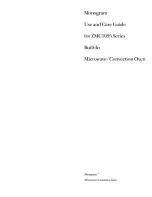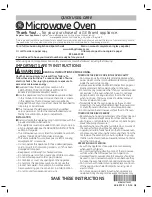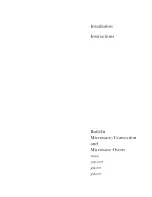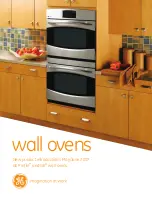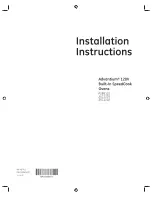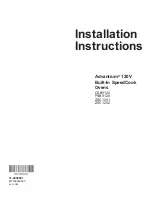
27
Baking tips
Roasting and grilling
Ovenware
You may use any heat
resistant ovenware. Always place the
ovenware in the middle of the wire rack. The enamelled baking
tray is also suitable for large roasts.
Roasting tips
■
A a lower temperature produces more even browning.
■
Depending on the size of the joint, add 2 or 3 tablespoons of
liquid to lean meat and 8 to 10 tablespoons of liquid to pot
roasts.
■
When cooking duck or goose, pierce the skin on the
underside of the wings to allow the fat to run out.
■
Poultry will turn out particularly crispy and brown if you baste
it towards the end of the roasting time with butter, salted
water or orange juice.
■
Turn pieces of meat halfway through the cooking time.
■
When the roast is ready, turn off the oven and allow it to rest
for an additional 10 minutes. This will allow the meat juices to
distribute themselves better inside the roast.
■
When roasting large pieces of meat, you may find that the
amount of steam and condensation on the oven door is more
than usual. This is a normal occurrence which has no effect
on the oven's performance. Once roasting is complete, dry
the oven door and window with a cloth.
■
If you are roasting on the wire rack, insert the enamelled
baking tray into shelf position 1 to collect the drips of fat.
Grilling tips
■
If possible, grill items should be of equal thickness. They
should be at least 2 to 3 cm thick. This ensures that they
brown evenly while also remaining succulent.
■
Place the food to be grilled in the centre of the wire rack.
Pour a little water into the enamelled baking tray and insert
this into the shelf position underneath the grill to collect the
drips of fat. Never place it on the cooking compartment floor.
■
Drizzle some oil over the food to be grilled before you place it
on the wire rack under the grill.
■
If the food to be grilled is thin, turn it over halfway through
grilling; if it is thick, turn it over several times during grilling.
Use tongs when turning the food to avoid piercing it and, in
the case of meat, to keep the meat juices inside the meat.
■
Dark meats such as lamb and beef brown better and more
quickly than light meats such as pork and veal.
Roasting tips
How to establish whether sponge cake
is baked through.
Approx. 10 minutes before the end of the baking time stated in the recipe, insert a cock-
tail stick into the cake at its deepest point. If no cake mixture sticks to the wood, the cake
is ready.
The cake collapses.
Use less fluid next time or set the oven temperature 10 degrees lower. Note the stirring
times indicated in the recipe.
The cake has risen high in the middle
and less around the edges.
Do not grease the sides of the springform cake tin. After baking, carefully loosen the
cake using a knife.
The cake is too dark on the top.
Place it lower in the oven, select a lower temperature and bake the cake for a little
longer.
The cake is too dry.
When it is done, make small holes in the cake using a cocktail stick. Then drizzle fruit
juice or an alcoholic drink over it. Next time, set the temperature 10 degrees higher and
reduce the baking time.
The bread or cake (e.g. cheesecake)
looks good but is sticky on the inside
(soggy with wet streaks).
Next time, use less liquid and bake at a lower temperature for slightly longer. For cakes
with a moist topping, bake the base first. Sprinkle it with almonds or bread crumbs and
then place the topping on top. Take care to follow recipes and baking times.
The pastries are not evenly browned.
Select a slightly lower temperature to ensure that the cake is baked more evenly. Excess
greaseproof paper can affect the air circulation. Always cut the greaseproof paper to suit
the size of the baking tray.
The bottom of a fruit flan is too light.
Place the cake one level lower the next time.
The fruit juice overflows.
Next time, use the deeper universal pan, if you have one.
Small baked items made out of yeast
dough stick to one another during bak-
ing.
There should be a gap of approx. 2 cm around each item. This gives enough space for
the baked items to expand and turn brown on all sides.
Condensation forms when you bake
moist cakes.
Baking may create water vapour, which escapes above the door. The steam may settle
and form water droplets on the control panel or on the fronts of adjacent units. This is a
natural process.
How can you tell when the roast is
ready?
Use a meat thermometer (available from specialist retailers) or carry out a "spoon test".
Press down on the roast with a spoon. If it feels firm, it is ready. If the spoon can be
pressed in, it needs to be cooked for a little longer.
The roast is too dark and the crackling
is burnt in places.
Check the shelf position and temperature.
The roast looks good but the juices are
burnt.
Next time, use a smaller roasting dish and add more liquid.
The roast looks good, but the juices are
too clear and watery.
Next time, use a larger roasting dish and add less liquid.
Summary of Contents for HVA541NS0
Page 2: ......
Page 83: ......
Page 84: ...HVA541NS0 èeóªdG óbƒªdG ar ɪ à S G π dO 9000971541 914775555 940130 9000971541 ...































